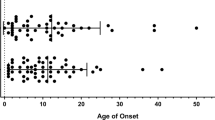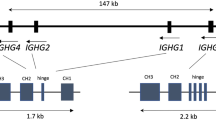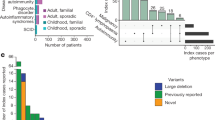Abstract
Coding variants in tumor necrosis factor receptor superfamily member 13B (TNFRSF13B) have been implicated in common variable immunodeficiency (CVID), but the functional effects of such mutations in relation to the development of the disease have not been entirely established. To examine the potential contribution of TNFRSF13B variants to CVID, we have applied an evolutionary approach by sequencing its coding region in 451 individuals belonging to 26 worldwide populations, in addition to controls, patients with CVID and selective IgA deficiency (IgAD) from Italy. The low level of geographical structure for the observed genetic diversity and the several neutrality tests performed confirm the absence of recent population-specific selective pressures, suggesting that TNFRSF13B may be involved also in innate immune functions, rather than in adaptive immunity only. A slight excess of rare derived alleles was found in patients with CVID, and thus some of these variants may contribute to the disease, implying that CVID probably fits the rare variants rather than the common disease/common variant paradigm. This also confirms the previous suggestion that TNFRSF13B defects alone do not cause CVID and that such an extremely heterogeneous immunodeficiency might be more likely related to additional, still unknown environmental and genetic factors.
This is a preview of subscription content, access via your institution
Access options
Subscribe to this journal
Receive 6 digital issues and online access to articles
$119.00 per year
only $19.83 per issue
Buy this article
- Purchase on Springer Link
- Instant access to full article PDF
Prices may be subject to local taxes which are calculated during checkout




Similar content being viewed by others
Accession codes
References
Ng LG, Sutherland AP, Newton R, Qian F, Cachero TG, Scott ML et al. B cell-activating factor belonging to the TNF family (BAFF)-R is the principal BAFF receptor facilitating BAFF costimulation of circulating T and B cells. J Immunol 2004; 173: 807–817.
Novak AJ, Darce JR, Arendt BK, Harder B, Henderson K, Kindsvogel W et al. Expression of BCMA, TACI, and BAFF-R in multiple myeloma: a mechanism for growth and survival. Blood 2004; 103: 689–694.
Mackay F, Schneider P . TACI, an enigmatic BAFF/APRIL receptor, with new unappreciated biochemical and biological properties. Cytokine Growth Factor Rev 2008; 19: 263–276.
Salzer U, Grimbacher B . Common variable immunodeficiency: the power of costimulation. Semin Immunol 2006; 18: 337–346.
Castigli E, Wilson SA, Garibyan L, Rachid R, Bonilla F, Schneider L et al. TACI is mutant in common variable immunodeficiency and IgA deficiency. Nat Genet 2005; 37: 829–834.
Salzer U, Chapel HM, Webster AD, Hammarstrom Q, Schmitt-Graeff A, Schlesier M et al. Mutations in TNFRSF13B encoding TACI are associated with common variable immunodeficiency in humans. Nat Genet 2005; 37: 820–828.
Castigli E, Wilson SA, Garibyan L, Rachid R, Bonilla F, Schneider L et al. Reexamining the role of TACI coding variants in common variable immunodeficiency and selective IgA deficiency. Nat Genet 2007; 39: 430–431.
Pan-Hammarström Q, Salzer U, Du L, Björkander J, Cunningham-Rundles C, Nelson DL et al. Reexamining the role of TACI coding variants in common variable immunodeficiency and selective IgA deficiency. Nat Genet 2007; 39: 429–430.
Lee JJ, Ozcan E, Rauter I, Geha RS . Transmembrane activator and calcium-modulator and cyclophilin ligand interactor mutations in common variable immunodeficiency. Curr Opin Allergy Clin Immunol 2008; 8: 520–526.
Salzer U, Bacchelli C, Buckridge S, Pan-Hammarstrom Q, Jennings S, Lougaris V et al. Relevance of biallelic versus monoallelic TNFRSF13B mutations in distinguishing disease-causing from risk-increasing TNFRSF13B variants in antibody deficiency syndromes. Blood 2009; 113: 1967–1976.
Ioannidis JP, Ntzani EE, Trikalinos TA, Contopoulos-Ioannidis DG . Replication validity of genetic association studies. Nat Genet 2001; 29: 306–309.
Aldea A, Calafell F, Aróstegui JL, Lao O, Rius J, Plaza S et al. The west side story: MEFV haplotype in Spanish FMF patients and controls, and evidence of high LD and a recombination ‘hot-spot’ at the MEFV locus. Hum Mutat 2004; 23: 399–406.
Sabater-Lleal M, Soria JM, Bertranpetit J, Almasy L, Blangero J, Fontcuberta J et al. Human F7 sequence is split into three deep clades that are related to FVII plasma levels. Hum Genet 2006; 118: 741–751.
Soldevila M, Andrés AM, Ramírez-Soriano A, Marquès-Bonet T, Calafell F, Navarro A et al. The prion protein gene in humans revisited: lessons from a worldwide resequencing study. Genome Res 2006; 16: 231–239.
Bamshad M, Wooding SP . Signatures of natural selection in the human genome. Nat Genet 2003; 4: 99–111.
Stephens JC, Schneider JA, Tanguay DA, Choi J, Acharya T, Stanley SE et al. Haplotype variation and linkage disequilibrium in 313 human genes. Science 2001; 293: 489–493.
Ferrer-Admetlla A, Bosch E, Sikora M, Marquès-Bonet T, Ramírez-Soriano A, Muntasell A et al. Balancing selection is the main force shaping the evolution of innate immunity genes. J Immunol 2008; 181: 1315–1322.
Tishkoff SA, Dietzsch E, Speed W, Pakstis AJ, Kidd JR, Cheung K et al. Global patterns of linkage disequilibrium at the CD4 locus and modern human origins. Science 1996; 271: 1380–1387.
Calafell F, Shuster A, Speed WC, Kidd JR, Kidd KK . Short tandem repeat polymorphism evolution in humans. Eur J Hum Genet 1998; 6: 38–49.
Tishkoff SA, Goldman A, Calafell F, Speed WC, Deinard AS, Bonne-Tamir B et al. A global haplotype analysis of the myotonic dystrophy locus: implications for the evolution of modern humans and for the origin of myotonic dystrophy mutations. Am J Hum Genet 1998; 62: 1389–1402.
Mateu E, Calafell F, Lao O, Bonné-Tamir B, Kidd JR, Pakstis A et al. Worldwide genetic analysis of the CFTR region. Am J Hum Genet 2001; 68: 103–117.
The Chimpanzee Sequencing and Analysis Consortium. Initial sequence of the chimpanzee genome and comparison with the human genome. Nature 2005; 437: 69–87.
Tjandra N . Establishing a degree of order: obtaining high-resolution NMR structures from molecular alignment. Structure 1999; 7: R205–R211.
Garibyan L, Lobito AA, Siegel RM, Call ME, Wucherpfennig KW, Geha RS . Dominant-negative effect of the heterozygous C104R TACI mutation in common variable immunodeficiency (CVID). J Clin Invest 2007; 117: 1550–1557.
Barbujani G, Magagni A, Minch E, Cavalli-Sforza LL . An apportionment of human DNA diversity. Proc Natl Acad Sci USA 1997; 94: 4516–4519.
Romualdi C, Balding D, Nasidze IS, Risch G, Robichaux M, Sherry ST et al. Patterns of human diversity, within and among continents, inferred from biallelic DNA polymorphisms. Genome Res 2002; 12: 602–612.
Moreno-Estrada A, Casals F, Ramírez-Soriano A, Oliva B, Calafell F, Bertranpetit J et al. Signatures of selection in the human olfactory receptor OR5I1 gene. Mol Biol Evol 2008; 25: 144–154.
Calafell F, Roubinet F, Ramírez-Soriano A, Saitou N, Bertranpetit J, Blancher A . Evolutionary dynamics of the human ABO gene. Hum Genet 2008; 124: 123–135.
Ramos-Onsis SE, Rozas J . Statistical properties of new neutrality tests against population growth. Mol Biol Evol 2002; 19: 2092–2100.
Ramírez-Soriano A, Ramos-Onsins SE, Rozas J, Calafell F, Navarro A . Statistical power analysis of neutrality tests under demographic expansions, contractions and bottlenecks with recombination. Genetics 2008; 179: 555–567.
Nachman MW, Crowell SL . Contrasting evolutionary histories of two introns of the duchenne muscular dystrophy gene, Dmd, in humans. Genetics 2000; 155: 1855–1864.
Harding RM, Healy E, Ray AJ, Ellis NS, Flanagan N, Tood C et al. Evidence for variable selective pressures at MC1R. Am J Hum Genet 2000; 66: 1351–1361.
Salzer U, Birmelin J, Bacchelli C, Witte T, Buchegger-Podbielski U, Buckridge S et al. Sequence analysis of TNFRSF13b, encoding TACI, in patients with systemic lupus erythematosus. J Clin Immunol 2007; 4: 372–377.
Inoue K, Mineharu Y, Inoue S, Yamada S, Matsuda F, Nozaki K et al. Search on chromosome 17 centromere reveals TNFRSF13B as a susceptibility gene for intracranial aneurysm: a preliminary study. Circulation 2006; 113: 2002–2010.
Lee WI, Huang JL, Kuo ML, Lin SJ, Chen LC, Chen MT et al. Analysis of genetic defects in patients with the common variable immunodeficiency phenotype in a single Taiwanese tertiary care hospital. Ann Allergy Asthma Immunol 2007; 99: 433–442.
Stoneking M . Human origins. The molecular perspective. EMBO Rep 2008; 9: S46–S50.
Maglione PJ, Chan J . 2009. How B cells shape the immune response against Mycobacterium tuberculosis. Eur J Immunol 2009; 39: 676–686.
Sabeti PC, Schaffner SF, Fry B, Lohmueller J, Varilly P, Shamovsky O et al. Positive natural selection in the human lineage. Science 2006; 312: 1614–1620.
Groom JR, Fletcher CA, Walters SN, Grey ST, Watt SV, Sweet MJ et al. BAFF and MyD88 signals promote a lupuslike disease independent of T cells. J Exp Med 2007; 204: 1959–1971.
Katsenelson N, Kanswal S, Puig M, Mostowski H, Verthelyi D, Akkoyunlu M . Synthetic CpG oligodeoxynucleotides augment BAFF- and APRIL-mediated immunoglobulin secretion. Eur J Immunol 2007; 37: 1785–1795.
Reich DE, Lander ES . On the allelic spectrum of human disease. Trends Genet 2001; 17: 502–510.
Fearnhead NS, Winney B, Bodmer WF . Rare variant hypothesis for multifactorial inheritance: susceptibility to colorectal adenomas as a model. Cell Cycle 2005; 4: 521–525.
Excoffier L, Laval G, Schneider S . Arlequin ver. 3.0: An integrated software package for population genetics data analysis. Evol Bioinformatics Online 2005; 1: 47–50.
Stephens M, Smith NJ, Donnely P . A new statistical method for haplotype reconstruction from population data. Am J Hum Genet 2001; 68: 978–989.
Stephens JC, Scheet P . Accounting for decay of linkage disequilibrium in haplotype inference and missing-data imputation. Am J Hum Genet 2005; 76: 449–462.
Graffelman J, Balding DJ, Gonzalez-Neira A, Bertranpetit J . Variation in estimated recombination rates across human populations. Hum Genet 2007; 122: 301–310.
Rozas J, Sánchez-Del Barrio JC, Messeguer X, Rozas R . DnaSp, DNA polymorphism analyses by the coalescent and others methods. Bioinformatics 2003; 19: 2496–2497.
Barrett JC, Fry B, Maller J, Daly MJ . Haploview: analysis and visualization of LD and haplotype maps. Bioinformatics 2005; 21: 263–265.
Bandelt HJ, Forster P, Sykes BC, Richards MB . Mitochondrial portraits of human populations using median networks. Genetics 1995; 141: 743–753.
Excoffier L, Smouse PE, Quattro JM . Analysis of molecular variance inferred from metric distances among DNA haplotypes: application to human mitochondrial DNA restriction data. Genetics 1992; 131: 479–491.
Slatkin M . A measure of population subdivision based on microsatellite allele frequencies. Genetics 1995; 139: 457–462.
Kruskal J . Nonmetric multidimensional scaling: a numerical method. Psychometrika 1964; 29: 28–42.
McDonald JH, Kreitman M . Adaptive protein evolution at the Adh locus in Drosophila. Nature 1991; 351: 652–654.
Hudson RR, Kreitman M, Aguadé M . A test of neutral molecular evolution based on nucleotide data. Genetics 1987; 116: 153–159.
Tajima F . Statistical method for testing the neutral mutation hypothesis by DNA polymorphism. Genetics 1989; 123: 585–595.
Fu YX, Li WH . Statistical tests of neutrality of mutations. Genetics 1993; 133: 693–709.
Fay JC, Wu CI . Hitchhiking under positive Darwinian selection. Genetics 2000; 155: 1405–1413.
Takahata N, Satta Y, Klein J . Divergence and population size in the lineage leading to modern humans. Theor Popul Biol 1995; 48: 198–221.
Myers S, Bottolo L, Freeman C, Mc Vean G, Donnely P . A fine-scale map of recombination rates and hotspots across the human genome. Science 2005; 310: 321–324.
Acknowledgements
This work was supported by Grants RFO ex 60% University of Bologna to DL, GSP02476 to SF, seventh framework programmes of the European Union Grant HEALTH-F2-2008-201549 to IQ and by Spanish Ministry of Science Grant BFU-63657 to FC.
Author information
Authors and Affiliations
Corresponding author
Rights and permissions
About this article
Cite this article
Sazzini, M., Zuntini, R., Farjadian, S. et al. An evolutionary approach to the medical implications of the tumor necrosis factor receptor superfamily member 13B (TNFRSF13B) gene. Genes Immun 10, 566–578 (2009). https://doi.org/10.1038/gene.2009.43
Received:
Revised:
Accepted:
Published:
Issue Date:
DOI: https://doi.org/10.1038/gene.2009.43
Keywords
This article is cited by
-
Protein and functional isoform levels and genetic variants of the BAFF and APRIL pathway components in systemic lupus erythematosus
Scientific Reports (2022)
-
Genome-wide association study identifies common variants at TNFRSF13B associated with IgG level in a healthy Chinese male population
Genes & Immunity (2012)



